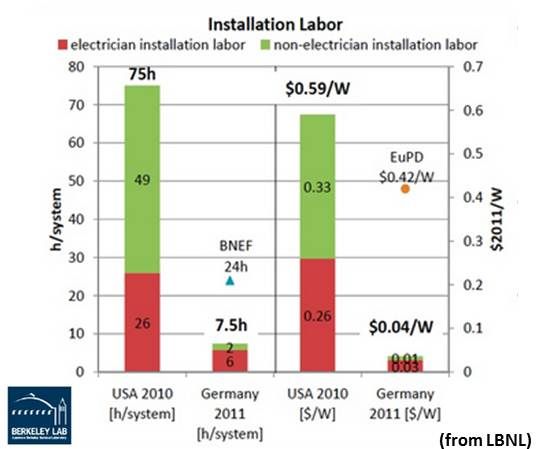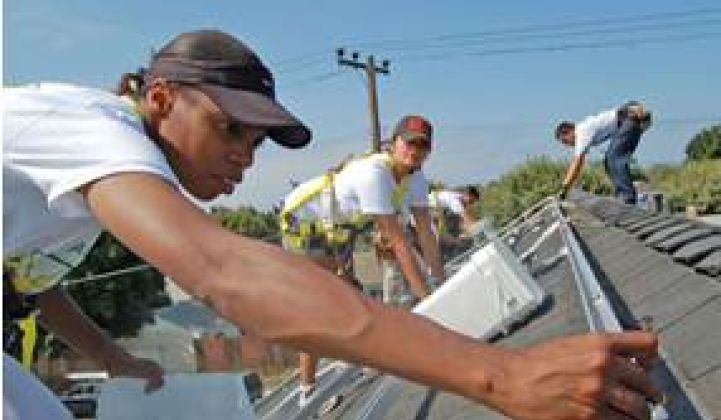While module prices plummet, the soft (non-hardware) costs of installing solar systems remain a stubborn barrier to affordability. The difference between the U.S. $4.44 per watt average installed cost for a typical residential rooftop system and the $2.24 per watt figure for comparable German systems, GTM recently reported, is in soft costs like customer acquisition, permitting, inspection and interconnection.
MEMC (NYSE:WFR) CEO Ahmad Chatila noted recently that the paperwork for permitting in Germany requires two pages, while U.S. permitting can require two trees' worth of paper.
Red tape is also the likely culprit responsible for putting average U.S. system installation time at 75 days versus 7.5 days in Germany.
A solar installer in one Southern California city can take a set of plans to the proper authority and get a permit to build within 48 hours, Paramount Solar VP and twelve-year solar industry veteran Todd Lindstrom recently said. But in a virtually indistinguishable city of the same size that is immediately adjacent, “If I get it done in under three weeks, it’s a miracle.”

NREL Solar Analyst Kristen Ardani and VoteSolar’s Adam Browning previewed a forthcoming U.S. soft cost update from NREL and LBNL researchers. The final data will be published by the U.S. Department of Energy (DOE) later this month. And DOE's SunShot program opened a new $10 million competition in September for “innovative, sustainable, and verifiable business practices that reduce these soft costs to $1 per watt.”
GTM asked Ardani and Browning for their observations on the two main industry-wide efforts underway to attack the complexities of permitting, inspection and interconnection that have U.S. installers tangled up in red.
One approach, led by third-party-finance leader Clean Power Finance (CPF), would create a national permitting database. The other, the Solar Freedom Now (SFN) movement co-founded by industry pioneer Barry Cinnamon, would gather political momentum to drive Congress to standardize procedures at the federal level.
In its winning bid for a $3 million DOE grant to create an online database of local permitting standards, CPF estimated it could cut the balance-of-system (BOS) soft costs of installing a five-kilowatt (DC) residential rooftop solar system by more than $0.22 per watt.
“Getting a permit is the choke point in the process,” CPF CEO Nat Kreamer said, "[and it is] driving solar companies crazy today. It’s time-consuming, it’s costly and it makes for a bad end-consumer experience.”

“We have to solve this problem,” SFN’s Cinnamon, a 30-plus-year solar veteran who has done everything from rooftop installs to running Westinghouse Solar (PINK: WEST), said. “The way we are going to solve it is on the national level because 18,000 cities, 3,000 utilities, 50 states, you’re never going to fix it everywhere."
There is, Cinnamon said, “a quicksand of stupid regulations and requirements and we need a policy standard to bring to lawmakers in Washington, D.C., which has two million people who want it.”
“Clean Power Finance has some great efforts under way with their permitting database that will disclose different requirements across jurisdictions,” Ardani said. “What we are hearing from installers is that something like a database, where you can go on and look at all the different requirements, could be a huge time-saving measure.”
Even knowing about increased paperwork could cut soft costs, she added. “Just deciphering and investigating what each jurisdiction is asking for is a huge time and cost expense.”
A database could also generate action from the bottom up that leads to more rationalized fee structures, Ardani suggested. “A lot of times what you see are fees that seem arbitrary. Why is this fee $300 and this fee $800?”
Browning’s VoteSolar group is planning to incorporate the CPF metrics on time, process, and cost into its own web tool that will allow installers “to click on a state and drill down to local jurisdictions.”

The website will be part of a VoteSolar effort to identify “best practices on eight different data points.” The objective, Browning said, is to get jurisdictions involved in setting “that gold standard of simplified and cost rational permitting.”
SFN’s drive for federal legislation should be pursued and could be successful, Browning said, but “given Congress’s complexity, and the fact that states and local jurisdictions fiercely guard their prerogative of local control, nobody should count on it.”
The good news, Browning said, “is there will be efforts from the top down and from the bottom up,” so the group says it “will get at it one way or the other.”
“The best thing,” Ardani said, “is to have best practices and drive toward them at the local jurisdiction level.”
"I wish we could get it done in one fell swoop at the federal level,” Browning said, “but our line around the office is, ‘If your plan involves Congress, it’s a bad plan.’”



